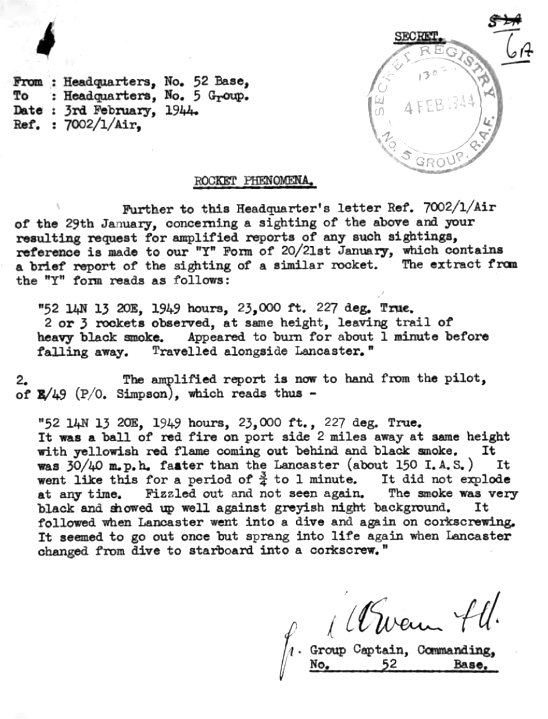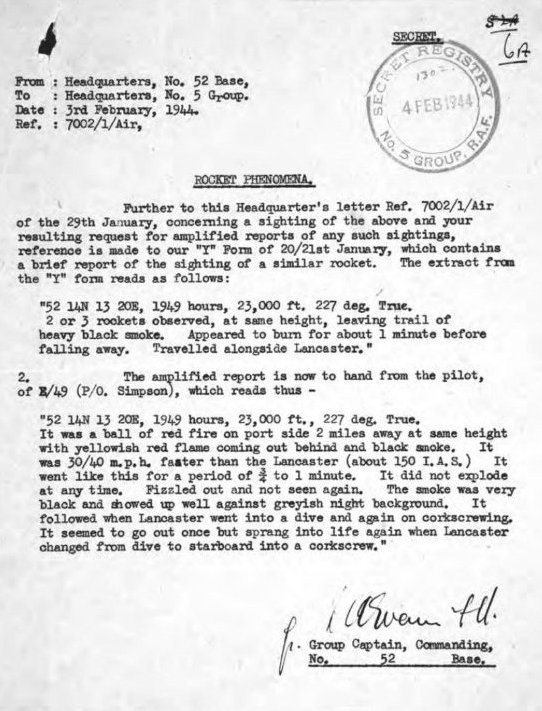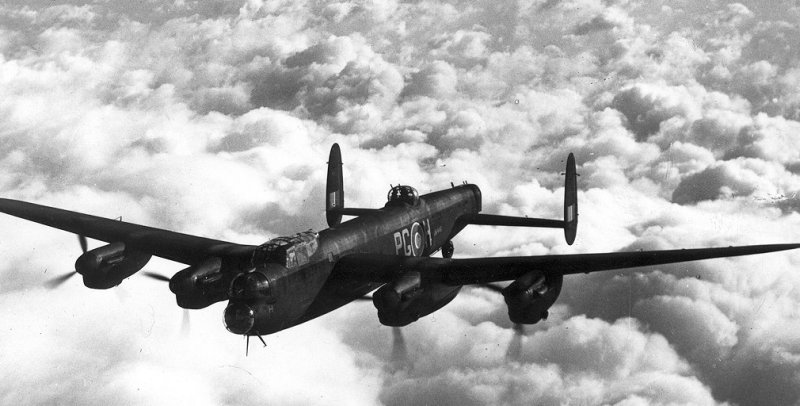ACUFO-1944-01-20-BERLIN-1
In his 2002 book “Out of the Shadows” with Andy Roberts, his 2003 book “Strange Secrets” written with Nick Redfern, and his 2013 book “The UFO Files: The Inside Story of Real-life Sightings”, Dr. David Clarke showed a report by No. 52 Squadron of the Royal Air Force (RAF), titled “AIR 14/2076: rocket phenomena” about a frightening aerial pursuit on the night of January 27, 1944. He explains that the commanding officer of No 49 Squadron was so mystified by the account that he personally asked the pilot, Pilot Officer Simpson, to amplify his initial report so it could be forwarded to the Headquarters of No. 5 Group. His report read:
“At 52 32N 13 03E, 2037 hours, 20,500 ft., heading 082 True. A red ball leaving trail of yellow/red flames and black smoke at about 1,000 yards and at the same height dead astern. It was seen closing in. I dived to starboard and the object followed, appearing to fizzle out and then immediately to reappear. I turned hard to port and it followed us round in a tighter turn than we were in. When within 100 yards or less of the aircraft, it finally fizzled out.”
Dr. David Clarke commented that while on the surface it sounded as though it could have been a very bright long-lasting type of meteor, bolide meteors do not chase aircraft.
In his 2013 book “The UFO Files”, Dr. David Clarke published a document found in the British National Archive in Kew, England, reference AIR 41/2076, as an example of a “rocket phenomenon” reported by RAF Bomber Command aircrews during World War II.
The document reveals that on January 20, 1944, at 07:49 p.m. UTC, from a Lancaster RAF bomber flying over Berlin in Germany on a heading of 227°, a ball of red fire was seen.
According to the pilot's amplified report, “it was a ball of red fire on port side (right) 2 miles away at same height with yellowish red flame coming out behind and black smoke.” It was flying 30 to 40 m.p.h. faster than the Lancaster bomber, continuing like this for a period of 3/4 to 1 minute.
It followed when the Lancaster went into a dive and followed again when the Lancaster went in a corkscrewing maneuver. It seemed to go out once, but sprang into life again when the Lancaster changed from a dive to the left into a corkscrew maneuver.
It did not explode at any time, it “fizzled out” and was not seen again.
The pilot described the smoke as very black and showing up well against greyish night background.
| Date: | January 20, 1944 |
|---|---|
| Time: | 07:49 p.m. |
| Duration: | 1 minute or more. |
| First known report date: | February 3, 1944. |
| Reporting delay: | Hours, 2 weeks. |
| Country: | Germany |
|---|---|
| State/Department: | Berlin |
| City or place: | Berlin |
| Number of alleged witnesses: | 1 or more. |
|---|---|
| Number of known witnesses: | 1 |
| Number of named witnesses: | 0 |
| Reporting channel: | Military Intelligence document. |
|---|---|
| Visibility conditions: | Night. |
| UFO observed: | Yes. |
| UFO arrival observed: | ? |
| UFO departure observed: | Yes. |
| UFO action: | Follows, follows escape maneuvers, goes off. |
| Witnesses action: | Escape maneuvers, dives, corkscrews. |
| Photographs: | No. |
| Sketch(s) by witness(es): | No. |
| Sketch(es) approved by witness(es): | No. |
| Witness(es) feelings: | Puzzled. |
| Witnesses interpretation: | ? |
| Sensors: |
[X] Visual: 1 or more.
[ ] Airborne radar: [ ] Directional ground radar: [ ] Height finder ground radar: [ ] Photo: [ ] Film/video: [ ] EM Effects: [ ] Failures: [ ] Damages: |
|---|---|
| Hynek: | NL |
| Armed / unarmed: | Armed, 8 7.62 mm machine guns. |
| Reliability 1-3: | 3 |
| Strangeness 1-3: | 2 |
| ACUFO: | Unidentified. |
[Ref. dcr1:] DR. DAVID CLARKE AND ANDY ROBERTS:
These authors explains that the most “foo-fighter” sightings during WWII were “passive”: the phenomena simply appeared from nowhere and vanished just as mysteriously, having no interaction with the airborne witnesses, but there were several cases where aircraft were “chased”.
He gives several examples from the British archive, including a frightening aerial pursuit that took place on the night of January 27, 1944.
Pilot Officer Simpson, who piloted the plane, made this report, appearing in “AIR 14/2076”, titled “rocket phenomena” by the Royal Air Force:
“At 52 32N 13 03E, 2037 hours, 20,500 ft., heading 082 True. A red ball leaving trail of yellow/red flames and black smoke at about 1,000 yards and at the same height dead astern. It was seen closing in. I dived to starboard and the object followed, appearing to fizzle out and then immediately to reappear. I turned hard to port and it followed us round in a tighter turn than we were in. When within 100 yards or less of the aircraft, it finally fizzled out.”
The officer commanding 49 Squadron was so mystified by this account that he personally asked Pilot Officer Simpson to amplify his initial report so it could be forwarded to the Headquarters of No. 5 Group.
The authors commented that whereas on the surface, the sighting sounds as though it could have been “a very bright long-lasting type of meteor known as a bolide”, bolide meteors are natural phenomena which do not chase aircraft; and moreover, these foofighter “chases” were often of great duration.
[Ref. nrr1:] NICK REDFERN AND ANDY ROBERTS:
A secret document of January 29, 1944, titled “Rocket Phenomena” shows that reports of encounters with unknown aerial objects continued to be filed by Royal Air Force crews:
At 52 32N 13 03E, 2037 hours, 20,500 ft., heading 082 degrees True. A red ball leaving trail of yellow/red flames and black smoke at about 1,000 yards and at the same height dead astern. It was seen closing in. I dived to starboard and the object followed, appearing to fizzle out and then immediately to reappear. I turned hard to port and it followed us round in a tighter turn than we were in. When Within l 00 yards or less of the aircraft, it finally fizzled out.
[Ref. snu1:] "SATURDAY NIGHT UFORIA" WEBSITE:
This website indicates that an incident appeared in a January 29, 1944, report titled Rocket Phenomena of a pilot with 49 Squadron:
“At 52 32N 13 03E, 2037 hours, 20,500 ft. heading 082 degrees True. A red ball leaving trail of yellow/red flames and black smoke at about 1000 yards and at the same height dead astern. It was seen closing in. I dived to starboard and the object followed, appearing to fizzle out and then immediately to reappear. I turned hard to port and it followed us round to a tighter turn than we were in. When with 100 years [yards] or less of the aircraft, it finally fizzled out.”
[Ref. dcr1:] DR. DAVID CLARKE:
This author indicates that a frightening aerial pursuit took place on the night of January 27, 1944; the commanding officer of 49 Squadron was so mystified by the account that he personally asked the pilot, Pilot Officer Simpson, to amplify his initial report so it could be forwarded to the Headquarters of No. 5 Group. His report read:
“At 52 32N 13 03E, 2037 hours, 20,500 ft., heading 082 True. A red ball leaving trail of yellow/red flames and black smoke at about 1,000 yards and at the same height dead astern. It was seen closing in. I dived to starboard and the object followed, appearing to fizzle out and then immediately to reappear. I turned hard to port and it followed us round in a tighter turn than we were in. When within 100 yards or less of the aircraft, it finally fizzled out.”
The author comments that while on the surface it sounds as though it could have been a very bright long-lasting type of meteor; but bolide meteors do not chase aircraft, and these foo-fighter 'chases' were often of great duration.
The author indicates that the reference of the pilot's report is “AIR 14/2076: rocket phenomena”, and he gives this report:

|
[Ref. nip1:] "THE NICAP WEBSITE":
[1944] Jan. 29, 1944; Location unknown
Red ball; yellow/red flames followed aircraft through evasive action. (Page 56 Ref.1)
The reference 1 is described at the end of the document as “Strange Company (2007), Keith Chester”.
[Ref. dce2:] DR. DAVID CLARKE:
British ufologist David Clarke or his colleague Andy Roberts showed the following report, from the British National Archive in Kew, reference AIR 41/2076, as an example of "rocket phenomena" reported by RAF Bomber Command aricrews during World War II:

|
SECRET
From: Headquarters, No. 52 Base,
To: Headquarters, No 5 Group
Date: 3rd February, 1944.
Ref: 7002/1/Air,
ROCKET PHENOMENA
Further to this Headquarters' letter Ref. 7002/1/Air of the 29th January, concerning a sighting of the above and your resulting request for amplified reports of any such sighting, referece is made to our “Y” Form of 20/2lst January, which contains a brief report of the sighting of a similar rocket. The extract from the “Y” form reads as follows:
“52 14N 13 20E, 1949 hours, 23,000 ft. 227 deg. True.
2 or 3 rockets observed, at same height, leaving trail ot heavy black smoke. Appeared to burn for about 1 minute before falling away. Travelled alongside Lancaster.”
2. The amplified report is now to hand from the pilot, of E/49 (P/O. Simpson), which reads thus -
“52 14N 13 20E, 1949 hours, 23,000 ft. 227 deg. True.
it was a ball of red fire on port side 2 miles away at same height with yellowish red flame coming out behind and black smoke. It was 30/40 m.p.h. faster than the Lancaster (about 150 I. A. S.) It went like this for a period of 3/4 to 1 minute. It did not explode at any time. Fizzled out and not seen again. The smoke was very black and showed up well against greyish night background. It followed when Lancaster went into a dive and again on corkscrewing. It seemed to go out once but sprang into life again when Lancaster changed from dive to starboard into a corkscrew.”
[Ref. tai1:] "THINK ABOUT IT" WEBSITE:
Date: Jan. 29, 1944
Location: Location unknown
Time:
Summary: Red ball; yellow/red flames followed aircraft through evasive action.
Source: Page 56 Ref.1
The Avro 683 Lancaster was a four-engine night bomber built in more than 7,000 units and it became, with the Handley Page Halifax, the main bomber of the Royal Air Force from 1942 on.
Its defense against German fighter planes was 8 7.62 mm machine guns.

|
The location is indicated by the coordinates: “52 14N 13 20E”. This is Berlin, in Germany.

|
Historical sources (Royal Air Force Bomber Command Campaign Diary, January 1944) indicate that in the night of January 20-21, 1944 Berlin bombed by 495 Lancasters, 264 Halifaxes, 10 Mosquitos of the Royal Air Force. They encountered German night fighters attacks; 22 Halifaxes and 13 Lancasters were lost.
Historical sources indicate that enemy opposition was waiting over Berlin where, with searchlights illuminating a layer of cloud at 12,000 feet, so the bombers were effectively seen in silhouette. There some combats with Messerschmitt Me-109's and Focke-Wulfe Fw-190's which attempted to attack from a blind spot underneath the bombers.
No. 49 Squadron was a bomber squadron of the Royal Air Force, operating Avro Lancaster long range night bombers in 1944.
It is entirely plausible that there were several witnesses to this sighting. The Lancaster had a crew of 7 men; they would certainly have all wondered about the motive for Pilot Simpson's evasive maneuvers. It was probably crew members other than the pilot who reported the presence of the light when it followed the plane, at such moments not visible to the pilot.
Historical sources indicate that this Lancaster of the 49th Squadron was registered EA-E. The pilot was John “Jock” Simpson. The navigator may have been Squadron Leader Jim Evans, or Squadron Leader Graham Day, or Denis Hiscock. The crew also included Frank Wheeler, Bob Mower, Arthur Highman, Colin Winterborn, Dennis “Johnny” Walker.
When I read the report [dce1], the first thought that came to my mind was: “Messerschmitt Me-262!”. I had in mind that a unit of Me-262's night fighter versions protected Berlin, around 1944 - 1945 according to what I vaguely remembered.
But...
Footage showing this plane in flight never show - except in cases of engine or fuel on fire - “very black smoke”.
Also, the reactor flame is not very visible, except during accelerations; and you must be behind the Me-262 to see it. If the Me-262 follows, it is not visible.
Also, its color was more bluish than “a ball of red fire”, “with yellowish red flame.”
Also, the report is about one yellowish red flame coming out behind the thing; there should be two since the Me-26 was twin-turbine.
Also - a fact almost constant in the cases of “Foo-Fighters” and “balls of fire” of the World War II - if these “things” were Messerschmitt Me-262's - or any other aircraft of German fighter anyway - how can we explain that they took the trouble to follow an enemy bomber in its dive and corkscrew maneuvers, without attacking it?
Finally, checking the dates, it turns out that 10/NJG11 (10th Gruppe) aka as Kommando Welter, had begun its night fighter role defending Berlin with Me-262 night fighters only from November 1944.
We will then wonder, forgetting certain points above, if it was another German rocket or jet plane. On the rocket side, we have the Messerschmitt Me-163 Komet.
Its “flame” was much more visible than that of the Me-262's nozzles. But it did not normally operate at night (I have an exception on a full moon night), its smoke was white instead of “very black”, and its speed was in fact much “too fast” to be “only” 30/40 mph faster than the Lancaster. Due to its speed, it would simply not have been able to follow the Lancaster in the dives and corkscrews, it would have “gone ahead” very quickly.
The Me-163 base closest to Berlin was 130 km south-southeast of Berlin, at Brandis. On the one hand Berlin would seem to be outside the 40 km range of Komets from Brandis, but moreover, these planes were only there from July 1944.
We have the Heinkel He-162 “Salamander”, aka “Volksjäger”, with its turbojet, but it was only operational from April 1945.
Some rare authors invoke a “Reichenberg” aircraft, a piloted pulse-jet plane, as an explanation for Foo-Fighters. No! The Fieseler Fi-103R Reichenberg was a V1 flying bomb to which a cockpit was added, dropped from a bomber. Several tests flights were made, all of them resulting in crashes, and in October 1944 the “Reichenberg” project was cancelled.
Let us also mention that during World War II, in Europe and the Pacific, a suspicion, almost a rumor, arose among certain bomber crews: the enemy would have used “decoys” called “Scarecrows” by Allied Intelligence, whose role would have been to simulate Allied bombers falling on fire in order to demoralize Allied aircrews. It turned out after the war that the “scarecrow” never existed, that the sightings were simply those of real bombers in distress.
I would quickly pass here on the thesis of German “radio-guided flying bombs”. On the one hand - I show it for other cases - none was operational as an anti-aircraft weapon, on the other hand, no anti-aircraft defense weapon had existed which would have been capable of ground guidance or wire guidance or visual guidance from an aircraft, to follow the Lancaster's maneuvers as described in the report.
In the end, the case leaves me perplexed, since on the one hand I have no obvious ordinary explanation and on the other hand the things described, with their flame, their black smoke, seem, vaguely, more terrestrial than extraterrestrial...
Unidentified.
* = Source is available to me.
? = Source I am told about but could not get so far. Help needed.
| Main author: | Patrick Gross |
|---|---|
| Contributors: | None |
| Reviewers: | None |
| Editor: | Patrick Gross |
| Version: | Create/changed by: | Date: | Description: |
|---|---|---|---|
| 0.1 | Patrick Gross | October 13, 2023 | Creation, [dce1], [nip1], [tai1]. |
| 1.0 | Patrick Gross | October 13, 2023 | First published. |
| 1.1 | Patrick Gross | November 8, 2023 | Addition [nrr1]. In the Summary, addition of "his 2003 book "Strange Secrets" written with Nick Redfern, and". |
| 1.3 | Patrick Gross | June 15, 2024 | Addition [dcr1]. |
| 1.0 | Patrick Gross | July 22, 2024 | Addition [dce2]. |